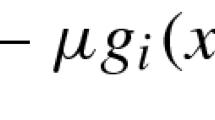Abstract
We develop a long-step surface-following version of the method of analytic centers for the fractional-linear problem min{t 0 |t 0 B(x) −A(x) εH, B(x) εK, x εG}, whereH is a closed convex domain,K is a convex cone contained in the recessive cone ofH, G is a convex domain andB(·),A(·) are affine mappings. Tracing a two-dimensional surface of analytic centers rather than the usual path of centers allows to skip the initial “centering” phase of the path-following scheme. The proposed long-step policy of tracing the surface fits the best known overall polynomial-time complexity bounds for the method and, at the same time, seems to be more attractive computationally than the short-step policy, which was previously the only one giving good complexity bounds.
Similar content being viewed by others
References
K.M. Anstreicher, A monotone projective algorithm for fractional linear programming,Algorithmica 1 (1986) 483–498.
C.R. Bector and A. Cambini, Fractional programming — Some recent results, in:Generalized Convexity and Fractional Programming with Economic Applications, Pisa, 1988, Lecture Notes in Economics and Mathematical Systems, Vol. 345 (Springer, Berlin, 1989) 493–504.
Y. Benadada, J.P. Crouzeix and J. Ferland, An interval-type algorithm for generalized fractional programming, in:Generalized Convexity and Fractional Programming with Economic Applications, Pisa, 1988, Lecture Notes in Economics and Mathematical Systems, Vol. 345 (Springer, Berlin, 1989) 106–120.
S. Boyd and L. El Ghaoui, Method of centers for minimizing generalized eigenvalue,Linear Algebra and Applications (Special Issue on Numerical Linear Algebra Methods in Control, Signals and Systems) 188 (1993) 63–111.
S. Boyd, L. El Ghaoui, E. Feron and V. Balakrishnan,Linear Matrix Inequalities in System and Control Theory (SIAM, Philadelphia, 1994).
W. Dinkelbach, On nonlinear fractional programming,Management Science 13 (1967) 492–498
J.A. Ferland and J.Y. Potvin, Generalized fractional programming: Algorithms and numerical experimentation,European Journal of Operational Research 20 (1985) 92–101.
R.W. Freund and F. Jarre, An interior-point method for convex fractional programming, AT&T Numerical Analysis Manuscript No. 93-03, Bell Laboratories, Murray Hill, NJ, 1993.
R.W. Freund and F. Jarre, An interior-point method for multi-fractional programs with convex constraints,Mathematical Programming 67 (1994) 407–440.
J.-P.A. Haeberly and M.L. Overton, A hybrid algorithm for optimizing eigenvalues of symmetric definite pencils,SIAM J. Matrix Anal. Appl. 15 (1994) 1141–1156.
J.-P.A. Haeberly and M.L. Overton, Optimizing eigenvalues of symmetric definite pencils, in:Proceedings of the 1994 American Control Conference, Baltimore, MD, 1994.
N. Karmarkar, A new polynomial-time algorithm for linear programming,Combinatorica 4 (1984) 373–395.
A. Nemirovski, On polynomiality of the method of analytic centers for fractional problems,Mathematical Programming 73 (1996) 175–198.
Yu. Nesterov, Long-step strategies in interior point potential reduction methods, Preprint, Department d’Economie Commerciale et Industrielle, Université de Geneve, Geneve, 1993.
Yu. Nesterov and A. Nemirovski, Multi-parameter surfaces of analytic centers and long-step path-following interior point methods, Research Report 2/94, Technion — Israel Institute of Technology, Haifa, 1993; also:Mathematics of Operations Research, to appear.
Yu. Nesterov and A. Nemirovskii,Interior Point Polynomial Algorithms in Convex Programming: Theory and Applications (SIAM, Philadelphia, 1994)
Yu. Nesterov and A. Nemirovskii, An interior point method for generalized linear-fractional problems,Mathematical Programming 69 (1995) 117–204.
J. Renegar, A polynomial time algorithm, based on Newton’s method, for linear programming,Mathematical Programming 40 (1988) 59–93.
S. Schaible, Bibliography in fractional programming,Zeitschrift für Operations Research 27 (1983) 211–241.
S. Schaible, Multi-ratio fractional programming — A survey, in:Optimization, Parallel Processing and Applications, Lecture Notes in Economics and Mathematical Systems, Vol. 304 (Springer, Berlin, 1988) 57–66.
G. Sonnevend, An “analytical centre” for polyhedrons and new classes of global algorithms for linear (smooth, convex) programming, in:System Modeling and Optimization, Budapest, Lecture Notes in Control and Information Sciences, Vol. 84 (Springer, Berlin, 1985) 866–875.
J. von Neumann, A model of general economic equilibrium,Review of Economic Studies 13 (1945) 1–9.
Y. Ye, On the von Neumann economic growth problem, Working Paper Series No. 92-9, March 1992, Department of Management Sciences, The University of Iowa, Iowa City, IA.
Author information
Authors and Affiliations
Additional information
The research was partly supported by the Israeli-American Binational Science Foundation (BSF).
Rights and permissions
About this article
Cite this article
Nemirovski, A. The long-step method of analytic centers for fractional problems. Mathematical Programming 77, 191–224 (1997). https://doi.org/10.1007/BF02614435
Received:
Issue Date:
DOI: https://doi.org/10.1007/BF02614435




